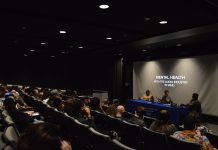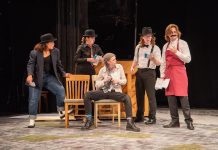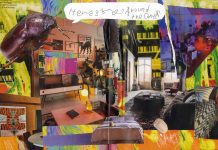By Holly Shanks
In a house filled with music and the smell of paint and turpentine, Dave Dyer grew up valuing art and developed an artistic eye through the support of amulti-generational, artistic family.
In 2009, the Webster Groves native and Webster University alumnus opened an entertainment-based company, Dyer Straits Productions (DSP). He and his

business partner, Susan Koerkenmeier, developed CON-TAMINATION, a yearly horror and pop culture convention, the only one of its kind in the St. Louis area.
After earning a Bachelor of Arts degree in graphic arts and illustration from Webster University in 1991, Dyer’s first job was as a graphic designer at a printing company. He then worked as a tattoo artist for over two decades. As an artist with a love of horror and science fiction, he was a natural at designing artwork for the genre.
The youngest of three brothers, Dyer doesn’t remember a time when he didn’t want to be an artist. In grade school, he created his own comics and comic book characters, which he printed on his father’s Xerox machine. He laughs as he recalls using up the toner ink to create copies, which he sold for five cents at school.
“I always drew. That’s just what I did because it comes from my family,” Dyer said. “My two older brothers were artists and my mom was the queen artist…and it just was natural that I would be an artist.”
Dyer’s oldest brother, Wilson Dyer, is a Hollywood sound editor that has won four Primetime Emmy Awards for “Star Trek: The Next Generation,” and currently is a sound editor for the CBS television drama “NCIS: Los Angles.”
Dyer’s love of horror and science fiction began with one movie, the original “Planet of the Apes.” As for his thoughts on the 2011 remake, “Rise of the Planet of the Apes,” starring James Franco — “Pure trash.”
“The reason why the original ‘Planet of the Apes’ worked was because of the human element in it. The actors were in costume, which gave them an eerie, human quality,” Dyer said. “There isn’t any reason to remake a film. Giving something a modern twist or a modern flare for today’s youth doesn’t necessarily make it better.”
Dyer traveled around the Midwest to different genre shows and conventions as a vendor in the late 1990s, selling things like toys and comics. He said he always wondered why genre conventions never came to St. Louis, and he realized it was not going to happen unless someone did something about it.
After two years of planning and work, the first CON-TAMINATION convention opened in St. Louis and brought horror, science fiction and pop culture together under one roof. The convention has drawn thousands of people since its induction in 2010.
“It’s like a mini Comic-Con, but with less comics and more horror, more pop culture and more science fiction,” Dyer said. “We did it because we wanted to see it happen in St. Louis. We think St. Louis deserves a show like this.”
Even though it takes a year of preparation to get ready for CON-TAMINATION, Dyer continues to do it because he loves it. He shares his love of art with his 11-year-old daughter, Violet. This year she helped with the convention and even designed one of the flyers.
Debora Bos, a volunteer staff member for CON-TAMINATION, has known Dyer for four years and said the conventions are an extension of his love for the horror and pop culture genre he shares with the fans who attend his event.
“[Dyer] is just a great guy. He does this because he wants to keep it alive and wants St. Louis to have a venue to be able to see their favorite stars from those ‘B’ movies,” Bos said. “He doesn’t make any money doing it. He just does it for the love of it.”
Dyer considers himself to have been a kind of outlaw during his time at Webster. He graduated disappointed with some aspects of the art program at that time. During that era, art design such as airbrushing was trending in the industry, but it was not part of the Webster curriculum. He would spend summers attending Meramec Community College to learn some of the newer techniques.
However, he was not disappointed with the art program in its entirety. Dyer found a mentor in his painting professor, Gary Passanise. He considers Passanise to be a great teacher and would highly recommend him to anyone studying art. Dyer also has fond memories of unique class assignments with Professor Bill Vann and considers him to have also been a phenomenal teacher.
Looking back, Dyer wishes he had learned more of the computer aspects of art and stayed on top of computer graphics programs. After decades as an artist and working in the industry, he has some insight he believes would be important for students studying art.
“Don’t get so consumed by only computer graphics that you don’t know how to pick up a paint brush and paint…” Dyer said. “Get back to the basics.”



